Series Content Conversations: Strategies for ELLs: Supporting Language & Content Learning in Math
Math.Practice.MP2
| Common core State Standards
- Math: Math
- Practice: Mathematical Practice Standards
-
MP2: Reason abstractly and quantitatively.
Mathematically proficient students make sense of quantities and their relationships in problem situations. They bring two complementary abilities to bear on problems involving quantitative relationships: the ability to decontextualize--to abstract a given situation and represent it symbolically and manipulate the representing symbols as if they have a life of their own, without necessarily attending to their referents—and the ability to contextualize, to pause as needed during the manipulation process in order to probe into the referents for the symbols involved. Quantitative reasoning entails habits of creating a coherent representation of the problem at hand; considering the units involved; attending to the meaning of quantities, not just how to compute them; and knowing and flexibly using different properties of operations and objects.
Math.HSF-IF.C.9
Common core State Standards
- Math: Math
- HSF-IF: High School: Functions: Interpreting Functions
- C: Analyze functions using different representations
-
9:
Compare properties of two functions each represented in a different way (algebraically, graphically, numerically in tables, or by verbal descriptions). For example, given a graph of one quadratic function and an algebraic expression for another, say which has the larger maximum.
Save to My Resources
PLEASE CREATE A NEW ACCOUNT OR LOG IN TO ACCESS THIS CONTENT
Enjoy your first video for free. Subscribe for unlimited access.
Have questions about subscribing?
Click Here to learn more about individual subscriptions.
Click Here to learn more about School and Institution access.
Discussion and Supporting Materials
Thought starters
- What are the benefits of allowing newcomer students to use their home language during math class?
- How does Ms. Segura scaffold the instruction throughout the lesson?
- What does Ms. Segura learn about the language demands of this lesson, and how does she use that knowledge to alter her instruction for the next class?
In Partnership With:

Teachers
Patricia Segura
Newest
|
4 MIN
|
5 MIN
|
5 MIN
UNCUT CLASSROOMS
| TCHERS' VOICE
English Language Arts

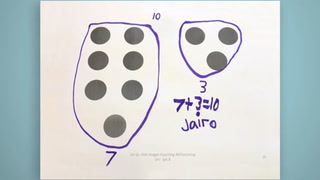
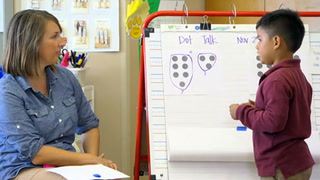
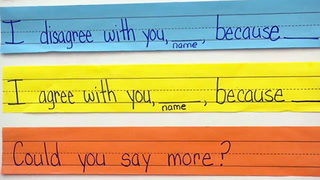
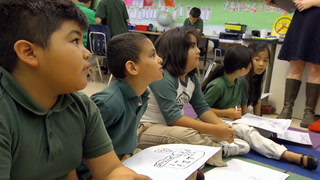


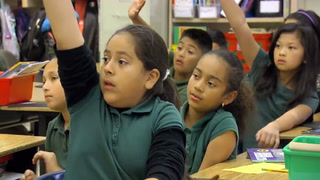
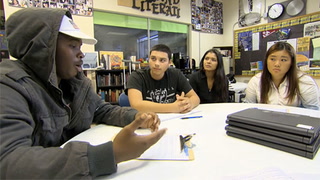
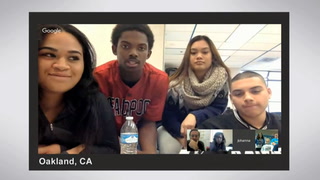
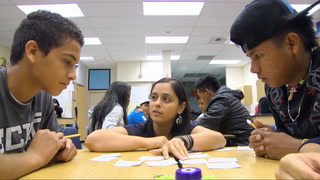
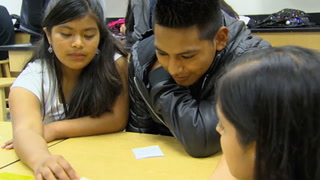









55 Comments
Constance Wright Mar 19, 2024 5:12pm
Ms. Sequra realizes when students begin to ask questions about the story being written in the past tense that she did not teach the present tense first for them to be able to make the connection to the past tense. Ms. Sequra used this knowledge to reverse her teaching of present and past tense for her next class.
Teresa Clark Dec 19, 2023 2:21pm
Avinus Calloway Sep 22, 2023 12:00pm
1. The benefits of allowing newcomers to use their home language during math class is that Ms. Sequra understands that if she allows them to speak in their language during this math class it gives clarification of the material to the students so that they are better able to engage in the lesson, have conversations with each other, and make real connection to the lesson.
2.How does Ms. Sequra scaffolld the instruction throughout the lesson ? Ms. Sequra scaffolds her lesson by giving the material in small pieces which allows the student to focus on just that piece of instruction, she also uses it as a tool to help students learn from other students.
3. What does Ms. Sequra learn about the language demands of this lesson, and how does she use that knowledge to alter her instruction? Ms. Sequra realizes when students begin to ask questions about the story being written in the past tense that she did not teach the present tense first in order for them to be able to make the connection to the past tense. Ms. Sequra used this knowledge to reverse her teaching of present and past tense for her next class.
Michael Daigre Sep 10, 2023 10:51pm
Ms. Segura allows the students to use their home language because the students were still able to work together and discuss the math problems. Because the teacher speaks English and Spanish she is able to listen to their group discussions. The teacher also knows that many of the students may have problems understanding English because it is not the students primary language. To offset this barrier she scaffolds the instructions so the students don't spend alot of time trying to read the instructions. However, during the group math assignment Ms. Segura notices that the students are still having problems reading the "situations" and has planned to use these observations to make adjustments to her lesson in the future.
Nakeisha Gardner Aug 20, 2023 7:01pm
1. The benefits of allowing newcomer students to use their home language during math class would be that they are able to articulate their responses in a group and partner setting in a language that they are comfortable speaking in.
2. Ms. Segura scaffold the instruction throughout the lesson by creating a more obtainable task for the assignment. She wanted the students to engage more with one another and be able to articulate in a clear manner so she made certain bullet points that needed to be discussed or addressed.
3. Ms. Segura learned about the language demands of the lesson, and that knowledge altered her instruction for the next class because she realized that the students did not learn about past tense and were having difficulty with the understanding how to complete the lesson. This realization led to her to review the vocabulary in the next class.